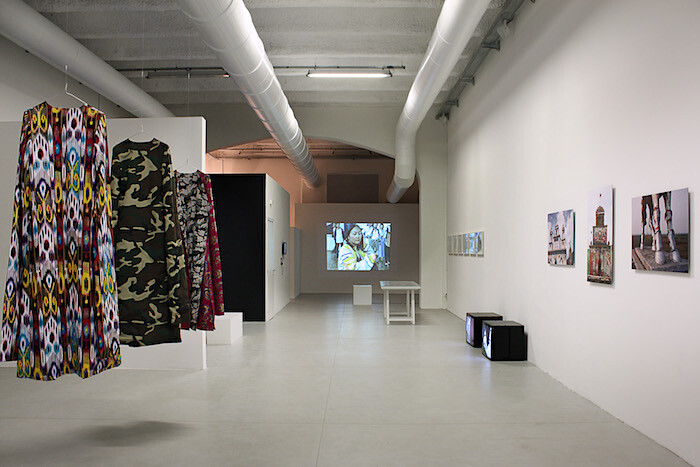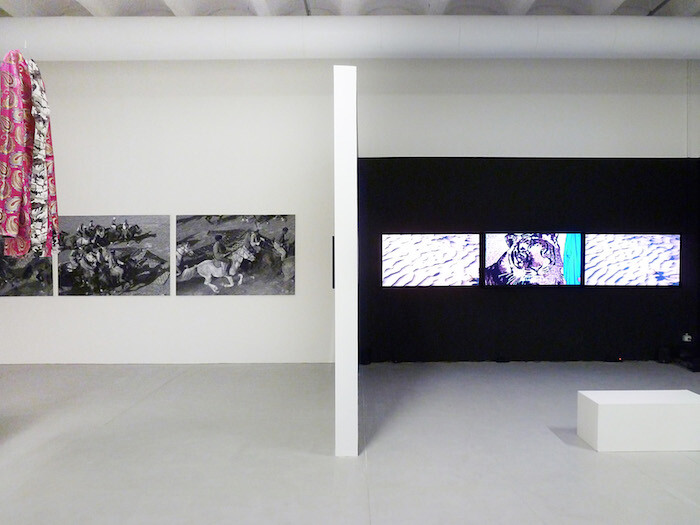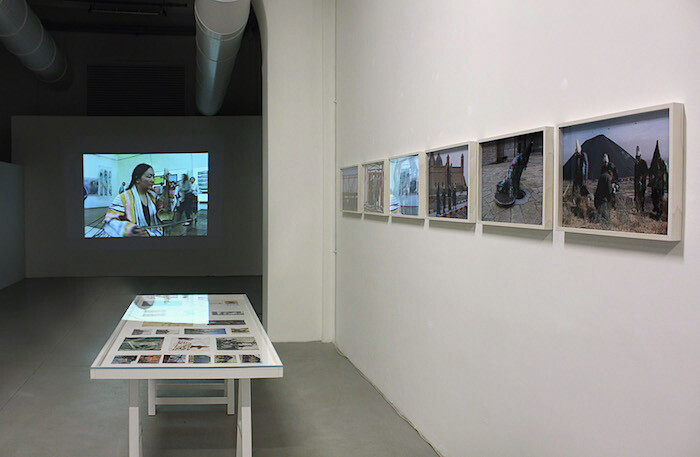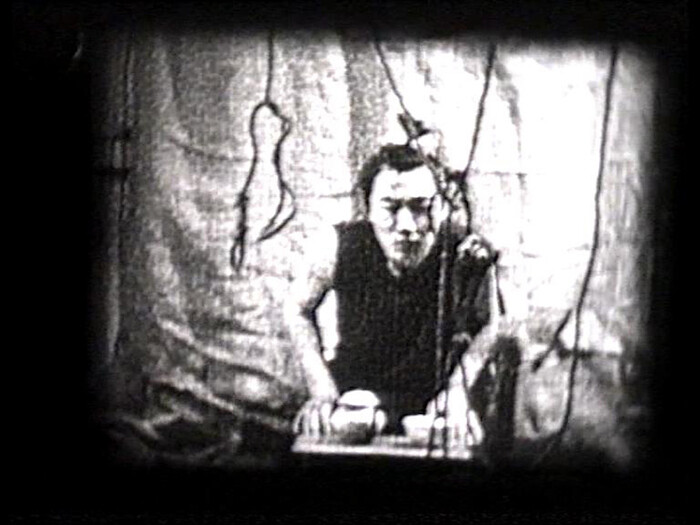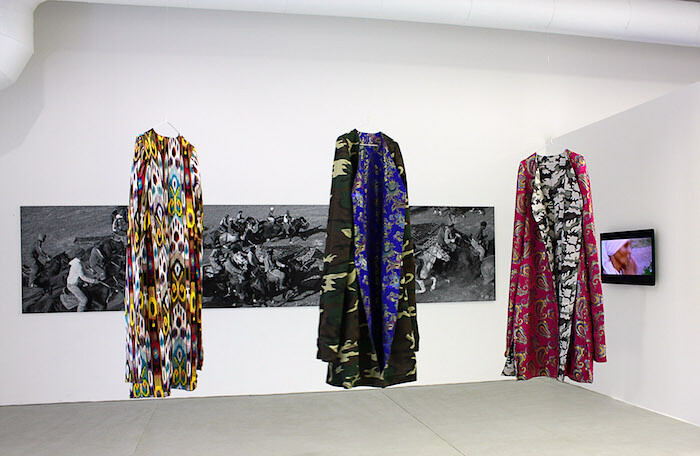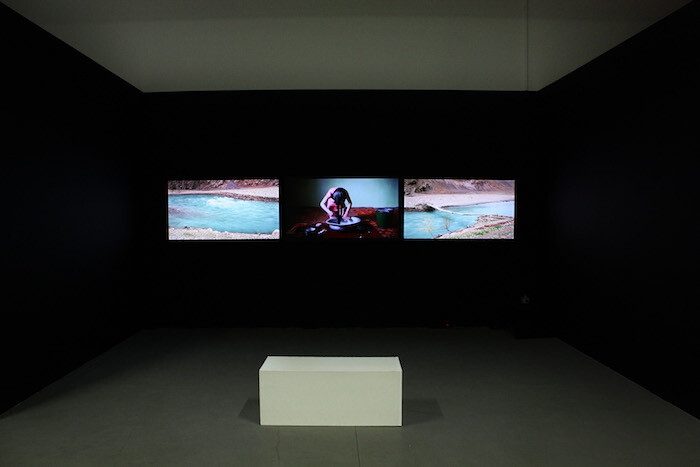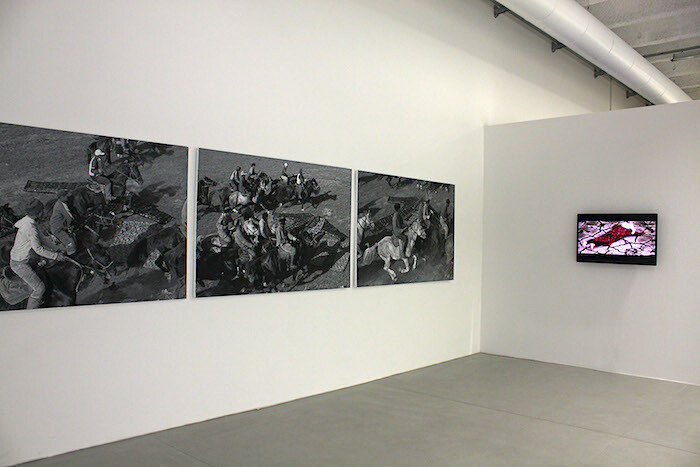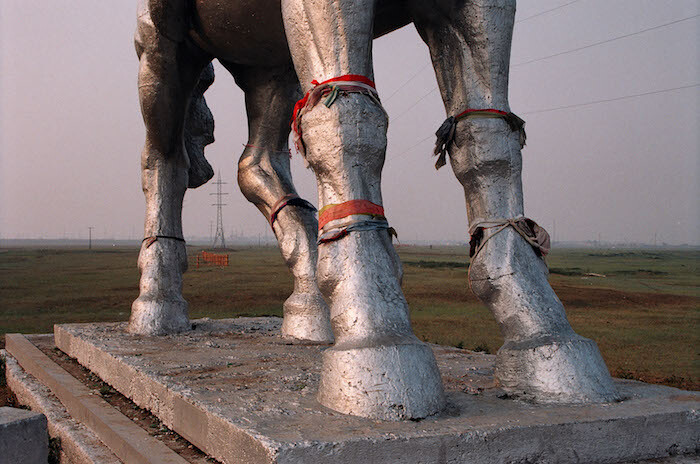One clean cut and—snip!—the plait of hair flops to the floor. Then comes the next braid—snip!—and the next—snip-snip! Strand by strand, all the remaining black hair of this Asian woman, dressed in traditional Kyrgyz garb, is sheared off by her own hand. It falls around her feet, leaving her neck bare. A black screen. The video starts over. We see the same woman again, now plucking the strings of an ancient instrument called the kyl kyyak, while a man braids the same long hair that will soon fall prey to her scissors. Around them, a swarm of people—random visitors to a museum in Bishkek, Kyrgyzstan—gape at the scene.
“This video/performance from 2001, titled Farewell Song, was inspired by an age-old custom in Kyrgyzstan, where women are supposed to let their hair grow until it is plaited into very thin braids for their wedding,” the gallery assistant tells me. “And so the scissors are symbolically severing all ties with a past that is felt to be stifling, in order to bid it farewell.” The artist seen here is Gulnara Kasmalieva, who along with with Muratbek Djumaliev (both live in Bishkek) seems to use the act of cutting (a leave-taking, a departure) as one that leads towards the (tribal, animistic, magical, nomadic) heart of their country, even as it yields a compelling visual image.
This interest in certain primal impulses is shared by the other artists in the show “Neon Paradise: Shamanism from Central Asia,” who are all from Kazakhstan, Kyrgyzstan, and Uzbekistan. These nations—parties to the Soviet communist adventure, ancient yet with a newly reshaped identity, and not yet trampled by tourists—have been at the center of Laura Bulian’s exhibition program for years now. Organized around national/geographic lines, like a national pavilion on a miniature scale within a commercial gallery (the majority of the works are photos and videos, all based on the folklorization and exoticization of marginalized Caucasian cultures, with almost no breath left between them), the show appeals to ethnic archetypes, stereotyped identities, legends, and the contaminated environment left behind by the Soviet era, remaking the intimate connection with tribal and spiritual practices in order to satisfy the desire for “a lost paradise.” But rather than describing a phenomenon, the title is meant to spark the imagination, and the exhibition therefore ranges from a documentary approach (like with the video Sham, 2004, also by Kasmalieva and Djumaliev, which depicts a pilgrim journeying to the slopes of the Kočkor Ata volcano in order to be healed), to others that are vividly playful (like the disconcerting 8mm film Tea Ceremony, 2001, by Kazakh artist Alexander Ugay, which condenses a thousand-year-old liturgy into two minutes of shaky footage), to others where shamanism infiltrates the real world in a more magical form.
Poetry is an undercurrent of the exhibition, giving the works a delicacy that never becomes overly marked. History is brought into play, but without making too many concessions to it: for instance, there are the reversible kaftans (United States Marine in Central Asia, 2008)—one side buta (paisley) silk, the other camouflage—by Said Atabekov (born in Uzbekistan, based in Kazakhstan), chameleon-like garments that eloquently convey the dialectic between tradition and contemporary forms of colonialism. Or his photos re-enacting epic battles (such as Genghis Khan’s Clothing, 2013). There are a dozen works here by Atabekov, including the video Neon Paradise (2003) which lends the exhibition its title: the artist, seen from behind, kneels in front of the sliding doors of a department store, as if the photocell were some modern-day spirit or demon.
The same penchant for poking fun inspires the Kyzyl Traktor group (“Red Tractor,” the first avant-garde movement to emerge in Kazakhstan after perestroika, to which Atabekov also belonged) to become makeshift shamans, as we see in the photos Journey to the East (2002): they wear colored tunics and pointy hats, crossing a red bridge or approaching a monument with an uncanny musical instrument on their shoulders, or going down a hatch while performing odd rituals. Vyacheslav Akhunov (born in Kyrgyzstan and based in Uzbekistan, which he is barred from leaving for political reasons) reinterprets the motif of ecstasy, drawing on Sufism in the two videos Ascent and Corner (both 2004): the former leads us up the spiral staircase of a medieval tower—the viewer almost gets winded—in an endless ascent, while in the latter the artist imprisons our gaze in corners of brick and stone.
Through it lingers on the parched bed of the Aral Sea, the three-channel video installation Stains of Oxus (2016) is anything but arid. Following the river Amu Darya (Oxus in Greek), Uzbek artist Saodat Ismailova has gathered the dreams and stories left by those who live along the river’s banks, letting them flow freely. The predominant message is that everything has a soul. A girl recounts her dream of a white horse. A man tells a legend: “There was a girl named Soman. She didn’t want to get married to an old man. She escaped her undesired spouse on a horse. When she arrived here she transformed herself into this lake, Soman.” And once again we find the image of the bride cutting all the ties that bind her, in a song of farewell, fleeing in order to become something else. Snip!—the braid is cut. At the end—in a particularly vivid scene—we see an old man brushing the hair of a little girl reluctantly crouched between his knees. “Now I’ll put your hair into a ponytail,” he tells her. The girl slips away. “She escaped again.”

